Tesco Plc: Accounting and Finance for Decision-Making Analysis
VerifiedAdded on 2023/06/11
|9
|2255
|214
Report
AI Summary
This report provides a financial diagnosis of Tesco Plc through an analysis of its income statement, balance sheet, and cash flow statement from 2019 to 2021. Key financial ratios such as gross profit ratio, operating ratio, net profit ratio, current ratio, quick ratio, return on equity, and debt-equity ratio are calculated and interpreted. The analysis reveals trends in Tesco's profitability, liquidity, and solvency, highlighting strengths like a significant increase in return on equity in 2021 and a manageable debt-equity ratio, alongside areas for improvement such as operational cash flow management. The report concludes that Tesco maintains a strong market position and delivers satisfactory returns to investors, emphasizing the importance of continued focus on expenditure reduction and balanced financing strategies. Desklib provides access to similar solved assignments and resources for students.
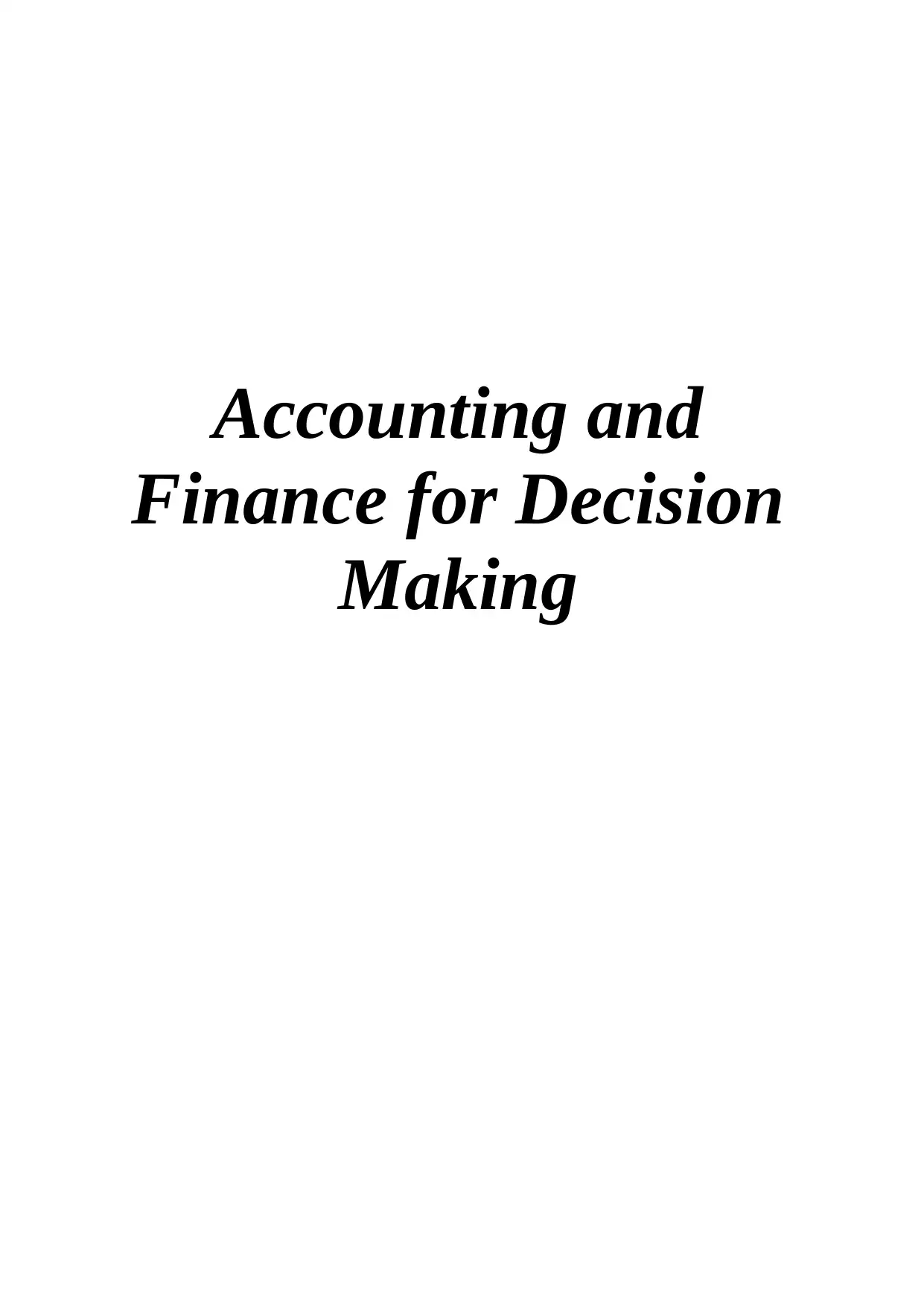
Accounting and
Finance for Decision
Making
Finance for Decision
Making
Paraphrase This Document
Need a fresh take? Get an instant paraphrase of this document with our AI Paraphraser

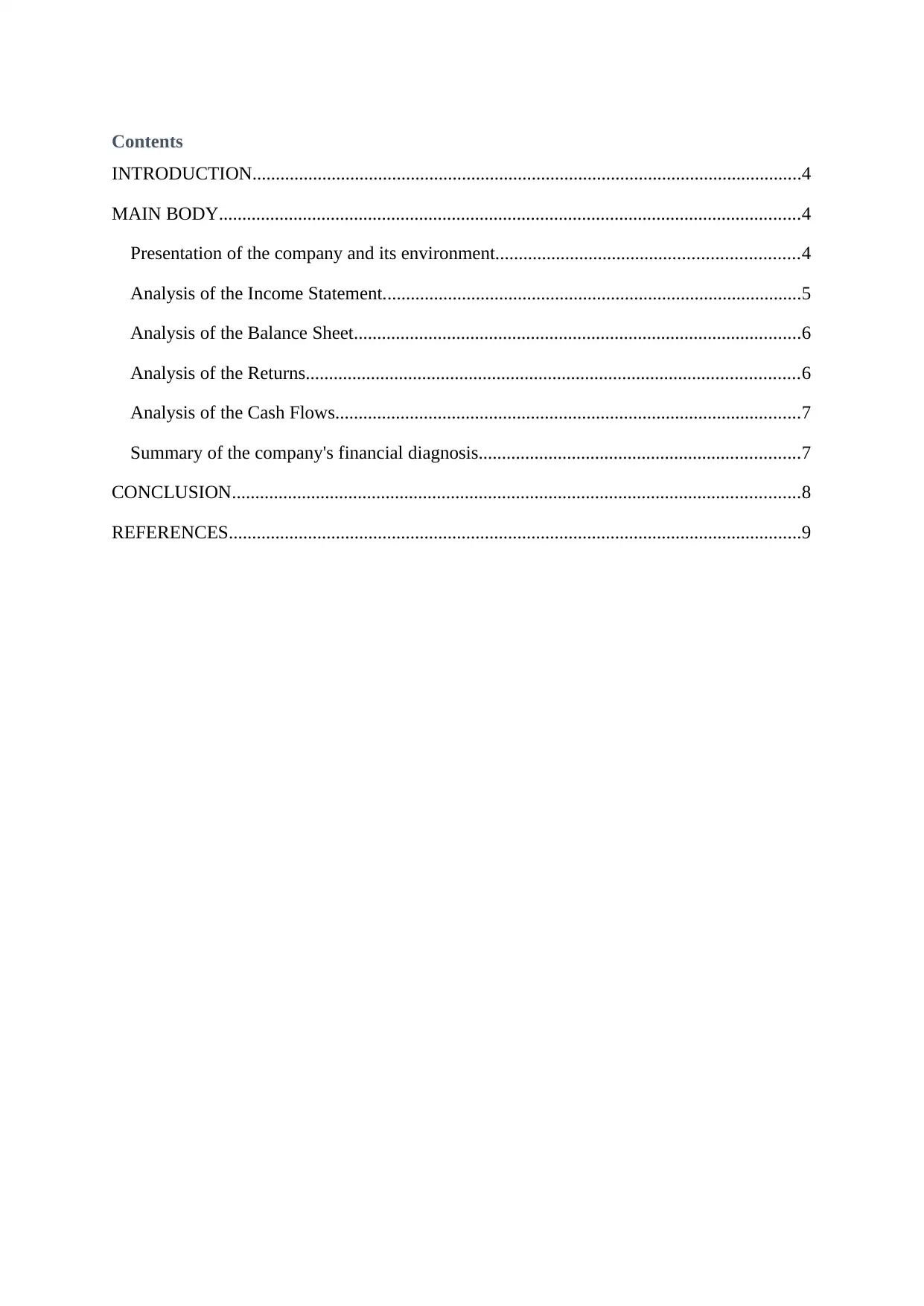
Contents
INTRODUCTION......................................................................................................................4
MAIN BODY.............................................................................................................................4
Presentation of the company and its environment.................................................................4
Analysis of the Income Statement..........................................................................................5
Analysis of the Balance Sheet................................................................................................6
Analysis of the Returns..........................................................................................................6
Analysis of the Cash Flows....................................................................................................7
Summary of the company's financial diagnosis.....................................................................7
CONCLUSION..........................................................................................................................8
REFERENCES...........................................................................................................................9
INTRODUCTION......................................................................................................................4
MAIN BODY.............................................................................................................................4
Presentation of the company and its environment.................................................................4
Analysis of the Income Statement..........................................................................................5
Analysis of the Balance Sheet................................................................................................6
Analysis of the Returns..........................................................................................................6
Analysis of the Cash Flows....................................................................................................7
Summary of the company's financial diagnosis.....................................................................7
CONCLUSION..........................................................................................................................8
REFERENCES...........................................................................................................................9
⊘ This is a preview!⊘
Do you want full access?
Subscribe today to unlock all pages.

Trusted by 1+ million students worldwide
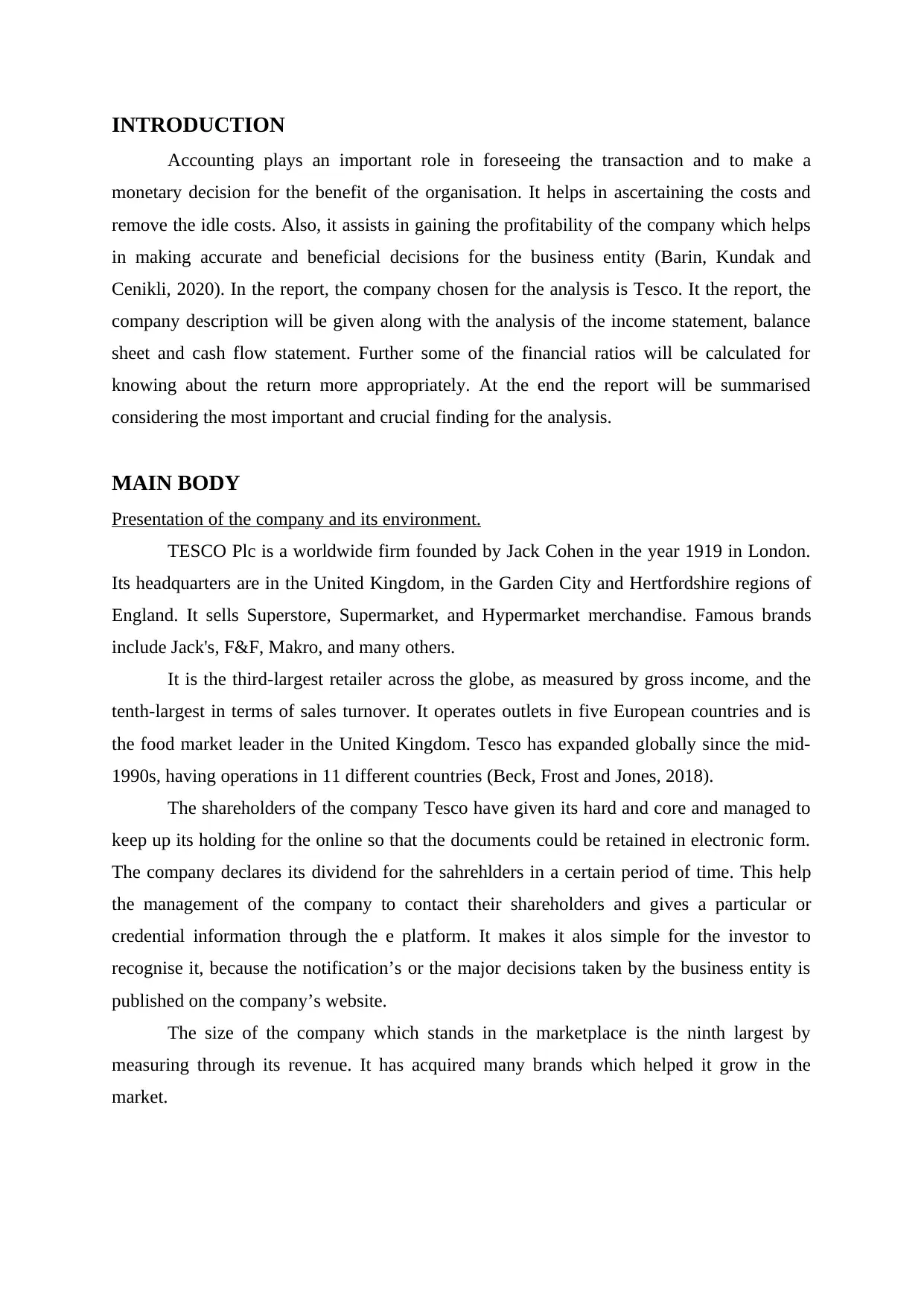
INTRODUCTION
Accounting plays an important role in foreseeing the transaction and to make a
monetary decision for the benefit of the organisation. It helps in ascertaining the costs and
remove the idle costs. Also, it assists in gaining the profitability of the company which helps
in making accurate and beneficial decisions for the business entity (Barin, Kundak and
Cenikli, 2020). In the report, the company chosen for the analysis is Tesco. It the report, the
company description will be given along with the analysis of the income statement, balance
sheet and cash flow statement. Further some of the financial ratios will be calculated for
knowing about the return more appropriately. At the end the report will be summarised
considering the most important and crucial finding for the analysis.
MAIN BODY
Presentation of the company and its environment.
TESCO Plc is a worldwide firm founded by Jack Cohen in the year 1919 in London.
Its headquarters are in the United Kingdom, in the Garden City and Hertfordshire regions of
England. It sells Superstore, Supermarket, and Hypermarket merchandise. Famous brands
include Jack's, F&F, Makro, and many others.
It is the third-largest retailer across the globe, as measured by gross income, and the
tenth-largest in terms of sales turnover. It operates outlets in five European countries and is
the food market leader in the United Kingdom. Tesco has expanded globally since the mid-
1990s, having operations in 11 different countries (Beck, Frost and Jones, 2018).
The shareholders of the company Tesco have given its hard and core and managed to
keep up its holding for the online so that the documents could be retained in electronic form.
The company declares its dividend for the sahrehlders in a certain period of time. This help
the management of the company to contact their shareholders and gives a particular or
credential information through the e platform. It makes it alos simple for the investor to
recognise it, because the notification’s or the major decisions taken by the business entity is
published on the company’s website.
The size of the company which stands in the marketplace is the ninth largest by
measuring through its revenue. It has acquired many brands which helped it grow in the
market.
Accounting plays an important role in foreseeing the transaction and to make a
monetary decision for the benefit of the organisation. It helps in ascertaining the costs and
remove the idle costs. Also, it assists in gaining the profitability of the company which helps
in making accurate and beneficial decisions for the business entity (Barin, Kundak and
Cenikli, 2020). In the report, the company chosen for the analysis is Tesco. It the report, the
company description will be given along with the analysis of the income statement, balance
sheet and cash flow statement. Further some of the financial ratios will be calculated for
knowing about the return more appropriately. At the end the report will be summarised
considering the most important and crucial finding for the analysis.
MAIN BODY
Presentation of the company and its environment.
TESCO Plc is a worldwide firm founded by Jack Cohen in the year 1919 in London.
Its headquarters are in the United Kingdom, in the Garden City and Hertfordshire regions of
England. It sells Superstore, Supermarket, and Hypermarket merchandise. Famous brands
include Jack's, F&F, Makro, and many others.
It is the third-largest retailer across the globe, as measured by gross income, and the
tenth-largest in terms of sales turnover. It operates outlets in five European countries and is
the food market leader in the United Kingdom. Tesco has expanded globally since the mid-
1990s, having operations in 11 different countries (Beck, Frost and Jones, 2018).
The shareholders of the company Tesco have given its hard and core and managed to
keep up its holding for the online so that the documents could be retained in electronic form.
The company declares its dividend for the sahrehlders in a certain period of time. This help
the management of the company to contact their shareholders and gives a particular or
credential information through the e platform. It makes it alos simple for the investor to
recognise it, because the notification’s or the major decisions taken by the business entity is
published on the company’s website.
The size of the company which stands in the marketplace is the ninth largest by
measuring through its revenue. It has acquired many brands which helped it grow in the
market.
Paraphrase This Document
Need a fresh take? Get an instant paraphrase of this document with our AI Paraphraser
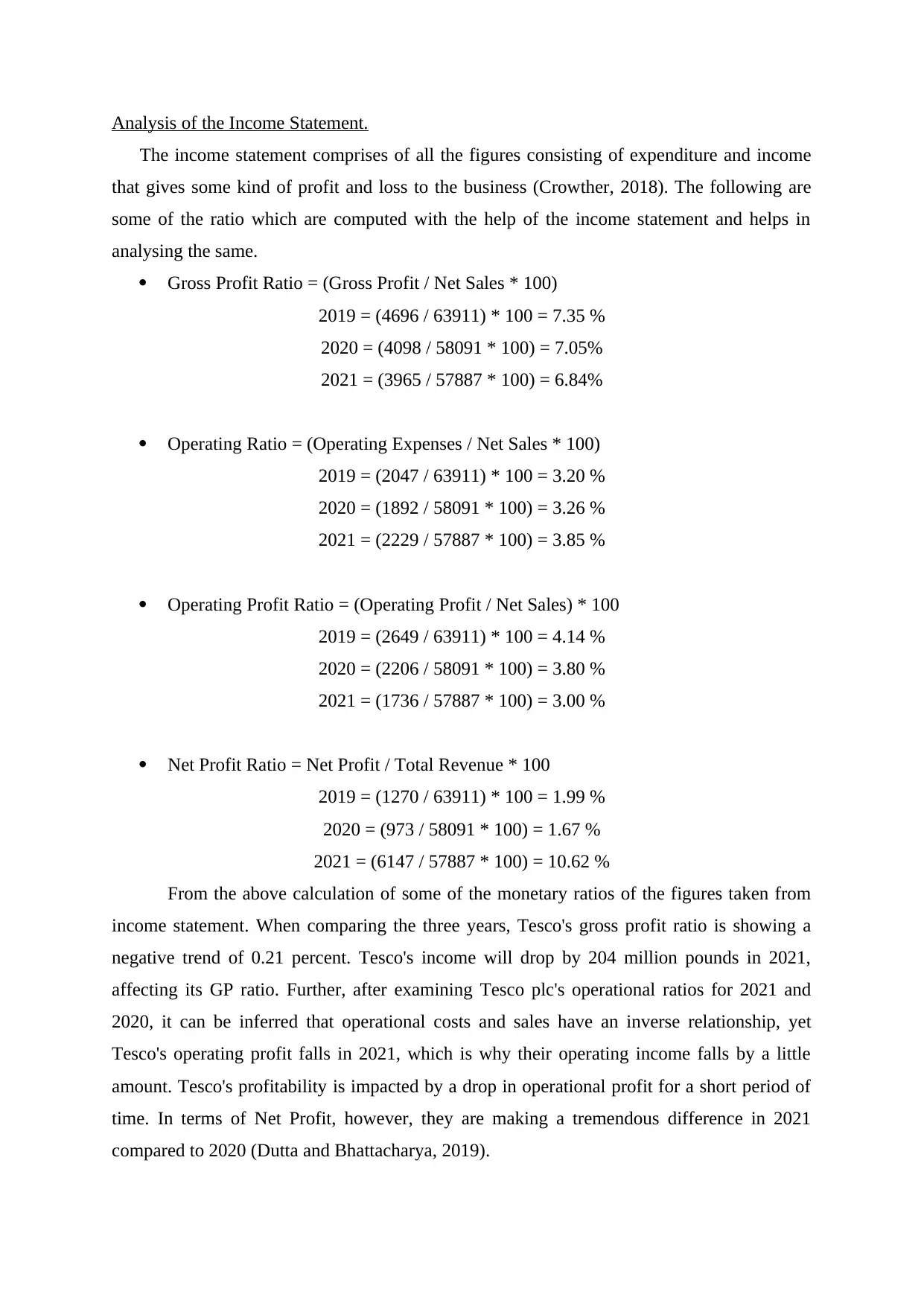
Analysis of the Income Statement.
The income statement comprises of all the figures consisting of expenditure and income
that gives some kind of profit and loss to the business (Crowther, 2018). The following are
some of the ratio which are computed with the help of the income statement and helps in
analysing the same.
Gross Profit Ratio = (Gross Profit / Net Sales * 100)
2019 = (4696 / 63911) * 100 = 7.35 %
2020 = (4098 / 58091 * 100) = 7.05%
2021 = (3965 / 57887 * 100) = 6.84%
Operating Ratio = (Operating Expenses / Net Sales * 100)
2019 = (2047 / 63911) * 100 = 3.20 %
2020 = (1892 / 58091 * 100) = 3.26 %
2021 = (2229 / 57887 * 100) = 3.85 %
Operating Profit Ratio = (Operating Profit / Net Sales) * 100
2019 = (2649 / 63911) * 100 = 4.14 %
2020 = (2206 / 58091 * 100) = 3.80 %
2021 = (1736 / 57887 * 100) = 3.00 %
Net Profit Ratio = Net Profit / Total Revenue * 100
2019 = (1270 / 63911) * 100 = 1.99 %
2020 = (973 / 58091 * 100) = 1.67 %
2021 = (6147 / 57887 * 100) = 10.62 %
From the above calculation of some of the monetary ratios of the figures taken from
income statement. When comparing the three years, Tesco's gross profit ratio is showing a
negative trend of 0.21 percent. Tesco's income will drop by 204 million pounds in 2021,
affecting its GP ratio. Further, after examining Tesco plc's operational ratios for 2021 and
2020, it can be inferred that operational costs and sales have an inverse relationship, yet
Tesco's operating profit falls in 2021, which is why their operating income falls by a little
amount. Tesco's profitability is impacted by a drop in operational profit for a short period of
time. In terms of Net Profit, however, they are making a tremendous difference in 2021
compared to 2020 (Dutta and Bhattacharya, 2019).
The income statement comprises of all the figures consisting of expenditure and income
that gives some kind of profit and loss to the business (Crowther, 2018). The following are
some of the ratio which are computed with the help of the income statement and helps in
analysing the same.
Gross Profit Ratio = (Gross Profit / Net Sales * 100)
2019 = (4696 / 63911) * 100 = 7.35 %
2020 = (4098 / 58091 * 100) = 7.05%
2021 = (3965 / 57887 * 100) = 6.84%
Operating Ratio = (Operating Expenses / Net Sales * 100)
2019 = (2047 / 63911) * 100 = 3.20 %
2020 = (1892 / 58091 * 100) = 3.26 %
2021 = (2229 / 57887 * 100) = 3.85 %
Operating Profit Ratio = (Operating Profit / Net Sales) * 100
2019 = (2649 / 63911) * 100 = 4.14 %
2020 = (2206 / 58091 * 100) = 3.80 %
2021 = (1736 / 57887 * 100) = 3.00 %
Net Profit Ratio = Net Profit / Total Revenue * 100
2019 = (1270 / 63911) * 100 = 1.99 %
2020 = (973 / 58091 * 100) = 1.67 %
2021 = (6147 / 57887 * 100) = 10.62 %
From the above calculation of some of the monetary ratios of the figures taken from
income statement. When comparing the three years, Tesco's gross profit ratio is showing a
negative trend of 0.21 percent. Tesco's income will drop by 204 million pounds in 2021,
affecting its GP ratio. Further, after examining Tesco plc's operational ratios for 2021 and
2020, it can be inferred that operational costs and sales have an inverse relationship, yet
Tesco's operating profit falls in 2021, which is why their operating income falls by a little
amount. Tesco's profitability is impacted by a drop in operational profit for a short period of
time. In terms of Net Profit, however, they are making a tremendous difference in 2021
compared to 2020 (Dutta and Bhattacharya, 2019).
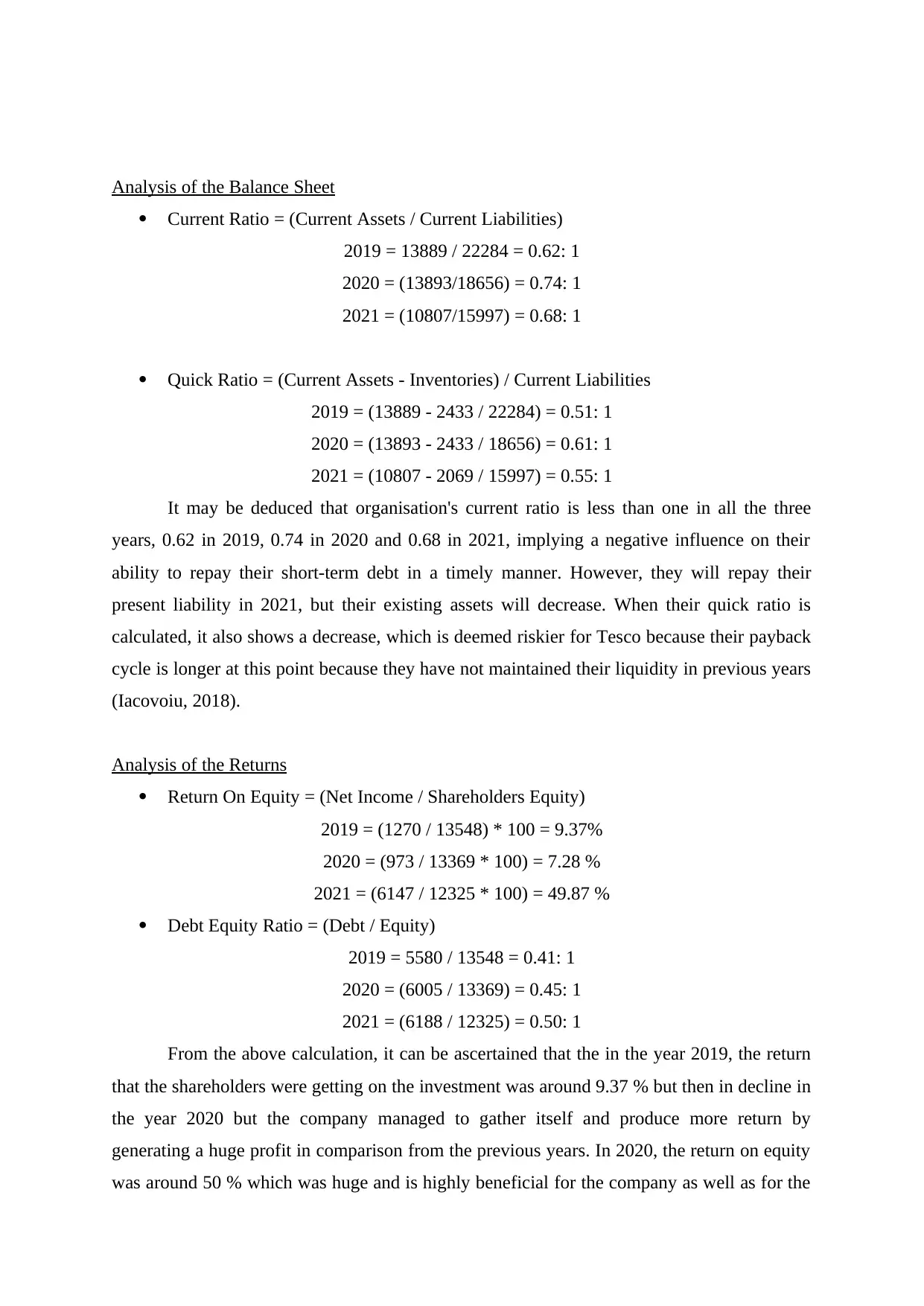
Analysis of the Balance Sheet
Current Ratio = (Current Assets / Current Liabilities)
2019 = 13889 / 22284 = 0.62: 1
2020 = (13893/18656) = 0.74: 1
2021 = (10807/15997) = 0.68: 1
Quick Ratio = (Current Assets - Inventories) / Current Liabilities
2019 = (13889 - 2433 / 22284) = 0.51: 1
2020 = (13893 - 2433 / 18656) = 0.61: 1
2021 = (10807 - 2069 / 15997) = 0.55: 1
It may be deduced that organisation's current ratio is less than one in all the three
years, 0.62 in 2019, 0.74 in 2020 and 0.68 in 2021, implying a negative influence on their
ability to repay their short-term debt in a timely manner. However, they will repay their
present liability in 2021, but their existing assets will decrease. When their quick ratio is
calculated, it also shows a decrease, which is deemed riskier for Tesco because their payback
cycle is longer at this point because they have not maintained their liquidity in previous years
(Iacovoiu, 2018).
Analysis of the Returns
Return On Equity = (Net Income / Shareholders Equity)
2019 = (1270 / 13548) * 100 = 9.37%
2020 = (973 / 13369 * 100) = 7.28 %
2021 = (6147 / 12325 * 100) = 49.87 %
Debt Equity Ratio = (Debt / Equity)
2019 = 5580 / 13548 = 0.41: 1
2020 = (6005 / 13369) = 0.45: 1
2021 = (6188 / 12325) = 0.50: 1
From the above calculation, it can be ascertained that the in the year 2019, the return
that the shareholders were getting on the investment was around 9.37 % but then in decline in
the year 2020 but the company managed to gather itself and produce more return by
generating a huge profit in comparison from the previous years. In 2020, the return on equity
was around 50 % which was huge and is highly beneficial for the company as well as for the
Current Ratio = (Current Assets / Current Liabilities)
2019 = 13889 / 22284 = 0.62: 1
2020 = (13893/18656) = 0.74: 1
2021 = (10807/15997) = 0.68: 1
Quick Ratio = (Current Assets - Inventories) / Current Liabilities
2019 = (13889 - 2433 / 22284) = 0.51: 1
2020 = (13893 - 2433 / 18656) = 0.61: 1
2021 = (10807 - 2069 / 15997) = 0.55: 1
It may be deduced that organisation's current ratio is less than one in all the three
years, 0.62 in 2019, 0.74 in 2020 and 0.68 in 2021, implying a negative influence on their
ability to repay their short-term debt in a timely manner. However, they will repay their
present liability in 2021, but their existing assets will decrease. When their quick ratio is
calculated, it also shows a decrease, which is deemed riskier for Tesco because their payback
cycle is longer at this point because they have not maintained their liquidity in previous years
(Iacovoiu, 2018).
Analysis of the Returns
Return On Equity = (Net Income / Shareholders Equity)
2019 = (1270 / 13548) * 100 = 9.37%
2020 = (973 / 13369 * 100) = 7.28 %
2021 = (6147 / 12325 * 100) = 49.87 %
Debt Equity Ratio = (Debt / Equity)
2019 = 5580 / 13548 = 0.41: 1
2020 = (6005 / 13369) = 0.45: 1
2021 = (6188 / 12325) = 0.50: 1
From the above calculation, it can be ascertained that the in the year 2019, the return
that the shareholders were getting on the investment was around 9.37 % but then in decline in
the year 2020 but the company managed to gather itself and produce more return by
generating a huge profit in comparison from the previous years. In 2020, the return on equity
was around 50 % which was huge and is highly beneficial for the company as well as for the
⊘ This is a preview!⊘
Do you want full access?
Subscribe today to unlock all pages.

Trusted by 1+ million students worldwide
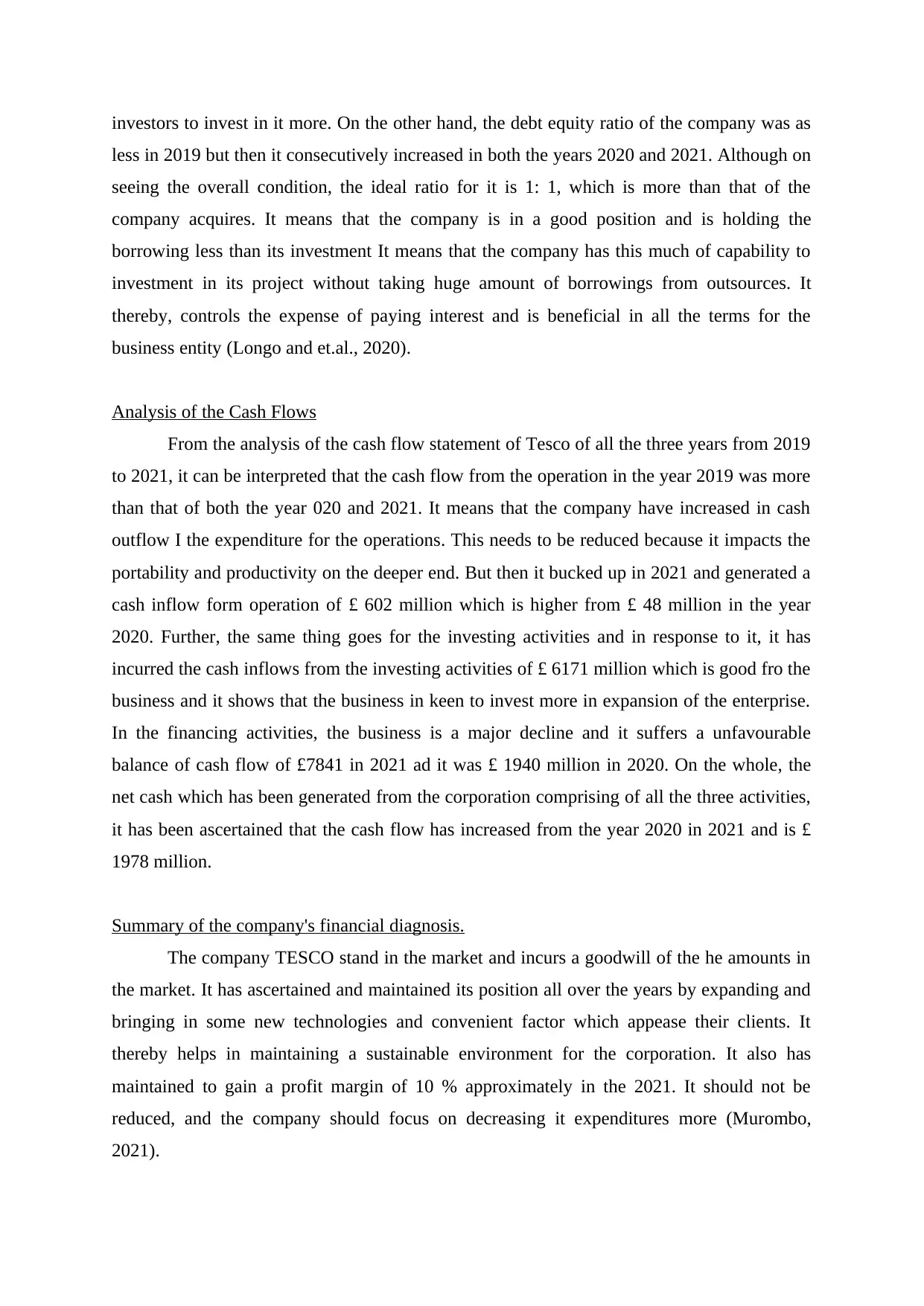
investors to invest in it more. On the other hand, the debt equity ratio of the company was as
less in 2019 but then it consecutively increased in both the years 2020 and 2021. Although on
seeing the overall condition, the ideal ratio for it is 1: 1, which is more than that of the
company acquires. It means that the company is in a good position and is holding the
borrowing less than its investment It means that the company has this much of capability to
investment in its project without taking huge amount of borrowings from outsources. It
thereby, controls the expense of paying interest and is beneficial in all the terms for the
business entity (Longo and et.al., 2020).
Analysis of the Cash Flows
From the analysis of the cash flow statement of Tesco of all the three years from 2019
to 2021, it can be interpreted that the cash flow from the operation in the year 2019 was more
than that of both the year 020 and 2021. It means that the company have increased in cash
outflow I the expenditure for the operations. This needs to be reduced because it impacts the
portability and productivity on the deeper end. But then it bucked up in 2021 and generated a
cash inflow form operation of £ 602 million which is higher from £ 48 million in the year
2020. Further, the same thing goes for the investing activities and in response to it, it has
incurred the cash inflows from the investing activities of £ 6171 million which is good fro the
business and it shows that the business in keen to invest more in expansion of the enterprise.
In the financing activities, the business is a major decline and it suffers a unfavourable
balance of cash flow of £7841 in 2021 ad it was £ 1940 million in 2020. On the whole, the
net cash which has been generated from the corporation comprising of all the three activities,
it has been ascertained that the cash flow has increased from the year 2020 in 2021 and is £
1978 million.
Summary of the company's financial diagnosis.
The company TESCO stand in the market and incurs a goodwill of the he amounts in
the market. It has ascertained and maintained its position all over the years by expanding and
bringing in some new technologies and convenient factor which appease their clients. It
thereby helps in maintaining a sustainable environment for the corporation. It also has
maintained to gain a profit margin of 10 % approximately in the 2021. It should not be
reduced, and the company should focus on decreasing it expenditures more (Murombo,
2021).
less in 2019 but then it consecutively increased in both the years 2020 and 2021. Although on
seeing the overall condition, the ideal ratio for it is 1: 1, which is more than that of the
company acquires. It means that the company is in a good position and is holding the
borrowing less than its investment It means that the company has this much of capability to
investment in its project without taking huge amount of borrowings from outsources. It
thereby, controls the expense of paying interest and is beneficial in all the terms for the
business entity (Longo and et.al., 2020).
Analysis of the Cash Flows
From the analysis of the cash flow statement of Tesco of all the three years from 2019
to 2021, it can be interpreted that the cash flow from the operation in the year 2019 was more
than that of both the year 020 and 2021. It means that the company have increased in cash
outflow I the expenditure for the operations. This needs to be reduced because it impacts the
portability and productivity on the deeper end. But then it bucked up in 2021 and generated a
cash inflow form operation of £ 602 million which is higher from £ 48 million in the year
2020. Further, the same thing goes for the investing activities and in response to it, it has
incurred the cash inflows from the investing activities of £ 6171 million which is good fro the
business and it shows that the business in keen to invest more in expansion of the enterprise.
In the financing activities, the business is a major decline and it suffers a unfavourable
balance of cash flow of £7841 in 2021 ad it was £ 1940 million in 2020. On the whole, the
net cash which has been generated from the corporation comprising of all the three activities,
it has been ascertained that the cash flow has increased from the year 2020 in 2021 and is £
1978 million.
Summary of the company's financial diagnosis.
The company TESCO stand in the market and incurs a goodwill of the he amounts in
the market. It has ascertained and maintained its position all over the years by expanding and
bringing in some new technologies and convenient factor which appease their clients. It
thereby helps in maintaining a sustainable environment for the corporation. It also has
maintained to gain a profit margin of 10 % approximately in the 2021. It should not be
reduced, and the company should focus on decreasing it expenditures more (Murombo,
2021).
Paraphrase This Document
Need a fresh take? Get an instant paraphrase of this document with our AI Paraphraser
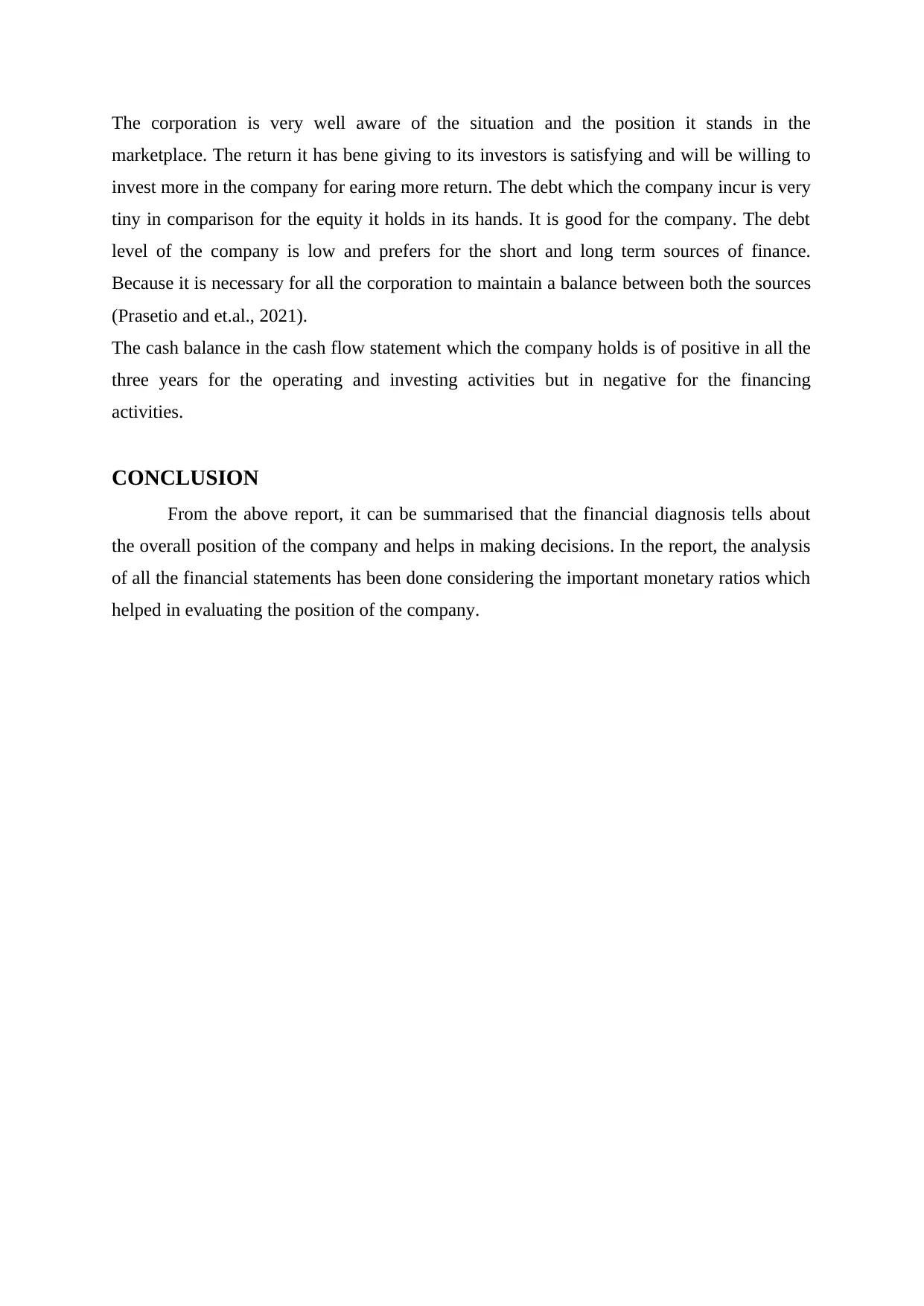
The corporation is very well aware of the situation and the position it stands in the
marketplace. The return it has bene giving to its investors is satisfying and will be willing to
invest more in the company for earing more return. The debt which the company incur is very
tiny in comparison for the equity it holds in its hands. It is good for the company. The debt
level of the company is low and prefers for the short and long term sources of finance.
Because it is necessary for all the corporation to maintain a balance between both the sources
(Prasetio and et.al., 2021).
The cash balance in the cash flow statement which the company holds is of positive in all the
three years for the operating and investing activities but in negative for the financing
activities.
CONCLUSION
From the above report, it can be summarised that the financial diagnosis tells about
the overall position of the company and helps in making decisions. In the report, the analysis
of all the financial statements has been done considering the important monetary ratios which
helped in evaluating the position of the company.
marketplace. The return it has bene giving to its investors is satisfying and will be willing to
invest more in the company for earing more return. The debt which the company incur is very
tiny in comparison for the equity it holds in its hands. It is good for the company. The debt
level of the company is low and prefers for the short and long term sources of finance.
Because it is necessary for all the corporation to maintain a balance between both the sources
(Prasetio and et.al., 2021).
The cash balance in the cash flow statement which the company holds is of positive in all the
three years for the operating and investing activities but in negative for the financing
activities.
CONCLUSION
From the above report, it can be summarised that the financial diagnosis tells about
the overall position of the company and helps in making decisions. In the report, the analysis
of all the financial statements has been done considering the important monetary ratios which
helped in evaluating the position of the company.

REFERENCES
Books and Journals
Barin, N.E., Kundak, S. and Cenikli, V.S., 2020. The Effects of Female Employment on
Economic Growth: An Application of Panel Data on the Member Countries of the
Organisation of Islamic Cooperation. In Contemporary Issues in Business
Economics and Finance. Emerald Publishing Limited.
Beck, C., Frost, G. and Jones, S., 2018. CSR disclosure and financial performance revisited:
A cross-country analysis. Australian Journal of Management, 43(4), pp.517-537.
Crowther, D., 2018. A Social Critique of Corporate Reporting: A Semiotic Analysis of
Corporate Financial and Environmental Reporting: A Semiotic Analysis of
Corporate Financial and Environmental Reporting. Routledge.
Dutta, S. and Bhattacharya, S., 2019. Cross selling of investment products and services: a
case study of leading financial services organisation. International Journal of
Business Forecasting and Marketing Intelligence, 5(2), pp.241-248.
Iacovoiu, V.B., 2018. An Empirical Analysis of Some Factors Influencing Financial
Literacy. Economic Insights-Trends & Challenges, 70(2).
Longo, C.J. and et.al., 2020. Financial toxicity associated with a cancer diagnosis in publicly
funded healthcare countries: a systematic review. Supportive Care in
Cancer, 28(10), pp.4645-4665.
Murombo, T., 2021. An assessment of the financial sustainability of Thandusana non-
governmental organisation.
Prasetio, J.E. and et.al., 2021. ACCOUNTING PERSPECTIVE ON THE ISLAMIC-
DRIVEN ACCOUNTABILITY IN A TRADITIONAL ISLAMIC
ORGANISATION IN JAVA. The International Journal of Accounting and Business
Society, 29(2).
Books and Journals
Barin, N.E., Kundak, S. and Cenikli, V.S., 2020. The Effects of Female Employment on
Economic Growth: An Application of Panel Data on the Member Countries of the
Organisation of Islamic Cooperation. In Contemporary Issues in Business
Economics and Finance. Emerald Publishing Limited.
Beck, C., Frost, G. and Jones, S., 2018. CSR disclosure and financial performance revisited:
A cross-country analysis. Australian Journal of Management, 43(4), pp.517-537.
Crowther, D., 2018. A Social Critique of Corporate Reporting: A Semiotic Analysis of
Corporate Financial and Environmental Reporting: A Semiotic Analysis of
Corporate Financial and Environmental Reporting. Routledge.
Dutta, S. and Bhattacharya, S., 2019. Cross selling of investment products and services: a
case study of leading financial services organisation. International Journal of
Business Forecasting and Marketing Intelligence, 5(2), pp.241-248.
Iacovoiu, V.B., 2018. An Empirical Analysis of Some Factors Influencing Financial
Literacy. Economic Insights-Trends & Challenges, 70(2).
Longo, C.J. and et.al., 2020. Financial toxicity associated with a cancer diagnosis in publicly
funded healthcare countries: a systematic review. Supportive Care in
Cancer, 28(10), pp.4645-4665.
Murombo, T., 2021. An assessment of the financial sustainability of Thandusana non-
governmental organisation.
Prasetio, J.E. and et.al., 2021. ACCOUNTING PERSPECTIVE ON THE ISLAMIC-
DRIVEN ACCOUNTABILITY IN A TRADITIONAL ISLAMIC
ORGANISATION IN JAVA. The International Journal of Accounting and Business
Society, 29(2).
⊘ This is a preview!⊘
Do you want full access?
Subscribe today to unlock all pages.

Trusted by 1+ million students worldwide
1 out of 9
Related Documents
Your All-in-One AI-Powered Toolkit for Academic Success.
+13062052269
info@desklib.com
Available 24*7 on WhatsApp / Email
![[object Object]](/_next/static/media/star-bottom.7253800d.svg)
Unlock your academic potential
Copyright © 2020–2025 A2Z Services. All Rights Reserved. Developed and managed by ZUCOL.





